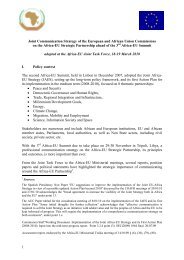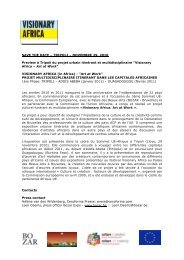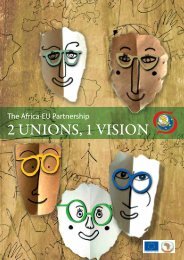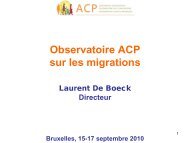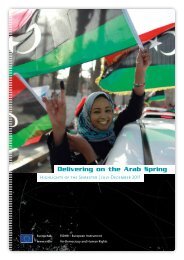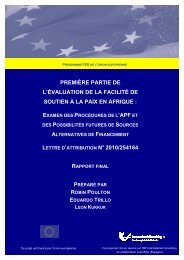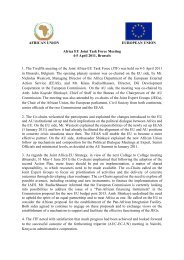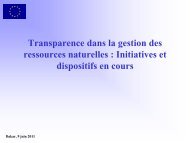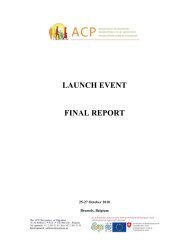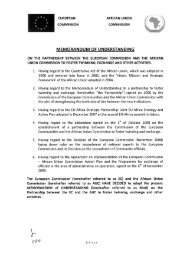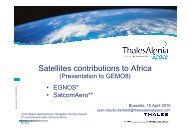part 1 of the african peace facility evaluation - European ...
part 1 of the african peace facility evaluation - European ...
part 1 of the african peace facility evaluation - European ...
You also want an ePaper? Increase the reach of your titles
YUMPU automatically turns print PDFs into web optimized ePapers that Google loves.
IV. MAIN FINDINGS AND RECOMMENDATIONS ON<br />
ALTERNATIVE FUNDING<br />
Stakeholders almost everywhere in <strong>the</strong> world describe <strong>the</strong> APF as an appropriate and effective<br />
instrument. Although concerns about limitations, constraints and shortcomings are raised, APF is<br />
almost invariably qualified as <strong>the</strong> best existing instrument for continental and regional <strong>peace</strong> building<br />
in Africa. The APF should <strong>the</strong>refore be seen as <strong>the</strong> best available instrument, but also as a tool that<br />
can be fur<strong>the</strong>r improved.<br />
A closer alignment <strong>of</strong> <strong>the</strong> funding instrument with political will and policy priorities may make it a more<br />
nimble funder, more <strong>of</strong>ten reflecting <strong>the</strong> reality behind <strong>the</strong> three objectives <strong>of</strong> <strong>the</strong> African EU<br />
Partnership on Peace and Security (i.e. <strong>the</strong> II Action Plan, 2011-2013) and encouraging a more<br />
reasonable division <strong>of</strong> labour between AU/EU, <strong>the</strong>ir respective MS and o<strong>the</strong>r relevant stakeholders. It<br />
is important not to see <strong>the</strong> APF as an isolated instrument, but to keep it at <strong>the</strong> heart <strong>of</strong> <strong>the</strong> full Africa-<br />
EU relationship. Likewise, it seems necessary to engage a broader range <strong>of</strong> relevant stakeholders and<br />
better link political decision making with quick delivery <strong>of</strong> specific initiatives.<br />
In a sense, EU member states may be reluctant to re-open <strong>the</strong> debate on APF funding at this stage.<br />
However, <strong>the</strong> world changes and <strong>the</strong> EU has a different legal and institutional set-up, which requires<br />
some adaptation. More flexibility, more predictability, more differentiation among APF components,<br />
implementation modalities and direct beneficiaries as well as more fluid procedures, adapted to<br />
military-type operational funding (including <strong>the</strong> possibility to fund a wider range <strong>of</strong> military costs) would<br />
increase effectiveness, results and value for money.<br />
To make meaningful recommendations on how improvements can be achieved, <strong>the</strong> nature and scope<br />
<strong>of</strong> funding sources must be critically evaluated. Links need to be made between what should be<br />
funded and <strong>the</strong> availability/suitability <strong>of</strong> future funding sources, by examining whe<strong>the</strong>r <strong>the</strong> right<br />
activities are properly funded.<br />
Although <strong>the</strong> scope <strong>of</strong> this <strong>evaluation</strong> does not include a detailed analysis, AMISOM does provide an<br />
example <strong>of</strong> a funding instrument intended for initiatives whose political dynamics is largely determined<br />
by o<strong>the</strong>r actors than <strong>the</strong> funding countries. A lack <strong>of</strong> constructive strategic discussion and political<br />
decision-making (for example, between UNSC, IGAD and countries with a stake in <strong>the</strong> future <strong>of</strong> <strong>the</strong><br />
region) leaves <strong>the</strong> EU and AU with a blurred political situation. This makes sensible funding decisions<br />
and planning for <strong>the</strong> best use <strong>of</strong> available funds very difficult. This example also reminds political<br />
decision-makers and technical staff <strong>of</strong> <strong>the</strong> risks involved in <strong>peace</strong> and security interventions as well as<br />
<strong>the</strong> requirement to use integrated risk management strategies, including mitigating measures.<br />
The recommendations below are largely based on financial information and compliance with expected<br />
outputs as well as interviews achieved during <strong>the</strong> <strong>evaluation</strong>. The phase II <strong>of</strong> <strong>the</strong> <strong>evaluation</strong> will<br />
provide an adequate and comprehensive picture <strong>of</strong> <strong>the</strong> APF, performance <strong>of</strong> <strong>the</strong> respective<br />
organisations, or ability to create and sustain value.<br />
Page 39 <strong>of</strong> 49




